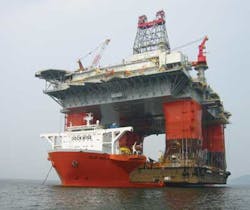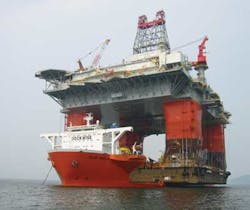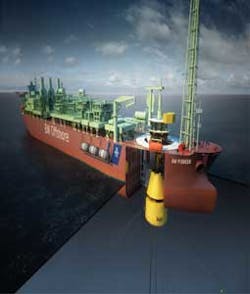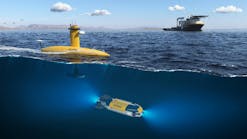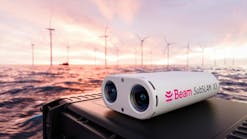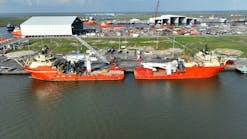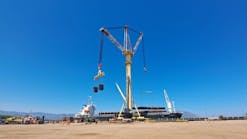Uwa Eigbe - INTECSEA
As offshore hydrocarbon developments move deeper and into more complex areas in the Gulf of Mexico (GoM), many technological challenges exist for operators and offshore engineering service providers.
These challenges are numerous and intertwined. Ultra-deepwater development teams need to pay particular attention to some specific considerations.
One of these is the choice of an economic and robust floater/platform and riser/mooring solution for drilling, production/storage, and workover operations. The GoM is one of the most hostile marine environments in the offshore oil and gas industry; therefore selection of the appropriate floater and riser typology is the key to a successful field development plan.
Long-distance tiebacks are another key consideration, especially where remote satellite fields in ultra-deepwaters pose significant flow assurance challenges. These challenges can include severe slugging and considerable sand deposition as well as hydrate formation, wax, and asphaltene deposition as pressure and temperature (P/T) decline along the flowline.
Depending on the well P/T, conventional subsea tieback technology is believed to be limited to a few tens of kilometers. Alternative tieback concepts are required for long-distance satellite fields, heavy fluids, or unfavorable well P/T conditions. Below are some key considerations.
HP/HT fluids. The fluids associated with most GoM deepwater/ultra-deepwater reservoirs present major mechanical design and material selection challenges for a wide range of subsea equipment, including rigid flowlines and pipelines, flexible pipe and other non-metallic (polymer) materials, subsea trees, manifolds, pipeline end termination structures (PLETS), spools/jumpers, and mechanical connections.
Marine geohazards. These conditions pose field layout/equipment location challenges, and flowline and pipeline routing challenges. The ultra-deepwater regions of the GoM consist of extensive fields of mega-furrows, which are a major concern for field development activities in those regions. The challenges of acquiring reliable seabed and soil data in ultra-deepwater also introduce additional design and installation challenges.
Offshore construction. Relatively few suitable vessels are available for deepwater/ultra-deepwater construction and installation operations, mainly due to load handling risks and capacity limitations. Vessels with higher capacities are under development and construction, which will improve availability. However, the experience gap, higher installation risks, and associated cost impact will remain a challenge.
The impact of technological step outs moving from deep to ultra-deep in terms of timely technology selection and maturation are not to be underestimated. A material or subsea equipment already applied to 1,000 m (3,280 ft), then selected for 2,500 m (8,202 ft) under similar conditions, often faces significant and lengthy qualification to achieve a similar level of confidence. The intervention of facilities or "putting things right" after the fact in the ultra-deep development is not a simple extrapolation of deepwater experience.
The successes so far achieved in overcoming these challenges can be attributed to several specific technologies.
Floater selection
With respect to floater selection, tension leg platforms (TLPs) have notably been the floater solution of choice in the GoM by major operators. There now seems to be a consensus that conventional TLPs may have a practical limit of around 5,000-ft (approx. 1,500-m) water depth due to constraints on tendon/riser loading. A trend emerging from this is the significant growth in the use of spar-based production platforms.
However, it is believed that spar-based platforms also may be practically limited to 9,000-ft (approx. 2,800-m) water depth for similar reasons. For ultra-deepwater (>7,500 ft), the future will likely see the continued use of the robust semisubmersible solution and, increasingly, the use of FPSOs such as that adopted for the Cascade/Chinook development.
New floater solutions are being developed to meet these challenges. Among these are the "motion enhanced," "higher payload" or "disconnectable" floating production systems. These are being developed by several operators and contractors in the industry.
Riser system selection
The main factors to consider in riser system selection are the floater/host facility, marine environment (metocean and seabed conditions), and the nature of the produced fluid. Top-tensioned risers (TTRs) have been used for most of the dry completion units (DCUs) in the GoM on TLP and spar-based platforms. However, as mentioned, the current generations of TTRs have water depth limitations.
Steel catenary risers (SCRs), which belong to the class of elegant and compliant catenary risers, have been used to tieback subsea satellite wells to existing TLPs and spar-based platforms. Depending on the diameter, these may prove to have similar water depth limitations to TTRs. Additional water depth capabilities may be achieved with the variant "lazy wave," "steep wave," and "steep S" catenary configurations and alternative top connections for specific environmental conditions.
Flexible pipe risers are not widely used in the GoM because they are less economical than the TTR and SCR alternatives. However, this may change for deeper applications where they can be envisaged as part of hybrid systems.
Future riser systems for ultra-deep conditions appear to favor hybrid types due to flexibility for the produced fluids, external environment and floater selection; and due to the fact they are rapidly gaining a track record for global deepwater field applications. These are essentially combinations of rigid pipe (carbon steel or corrosion resistant alloy), sometimes with polymer-type (wet) and/or pipe-in-pipe type insulation, with associated jumpers/connectors/structures and shallow-water flexible pipe to the floating structure. Examples of such systems are the free-standing hybrid riser (FSHR) and the tethered steel catenary riser (TSCR). INTECSEA is actively engaged in the development of hybrid solutions for future challenging ultra-deep developments.
To ensure the steady delivery of the produced fluid from subsea wells to the receiving facility, the challenge for long-distance tieback from satellite wells is to maintain fluid arrival temperatures at the host facility above the threshold for hydrate formation and wax deposition.
This currently is overcome with insulated flowline and riser systems (wet insulated and pipe-in-pipe systems). Pipe-in-pipe systems are generally more efficient than the wet insulated rigid flowline systems or flexible pipe in terms of insulation (U values less than 1.5 W/m2K are common compared with a generous limit of 2.0 W/m2K for the alternatives), and are destined for longer distance tieback or where higher arrival temperatures are desired.
Pipe-in-pipe use in ultra-deep developments presents significant technology challenges in selecting the best PIP configuration to address the (often competing) in-service and installation challenges. To minimize cold spots along the production system (areas of potential hydrate formation), several GoM deepwater projects have required the complete insulation of all subsea equipment installed in the field.
Insulation system selection
Turning to insulation materials, glass syntactic polyurethane (GSPU) or conventional PU is the most common wet insulation material, especially for intricate joints and equipment insulation. It has known water depth and temperature limitations. Five-layer polypropylene (5LPP) or similar arrangements of high performance polymers or silica gel materials have been recently used for ultra-deepwater applications.
For example, on the Cascade/Chinook project – currently the deepest field development in the GoM at 9,800 ft – the insulation solution for the pipe-in-pipe systems is aerogel, which is a highly efficient insulating material developed from nanotechnology and resistant to high temperature and external pressure. Even with state-of-the-art insulation systems and associated subsea technology, conventional subsea tieback distances remain limited. Thus, tiebacks longer than 100 km (62 mi) will continue to be a big step-out for most deepwater field development conditions.
To overcome this limitation, alternatives currently in operation in shallow water are now under development for use in deeper water. These include subsea separation, multi-phase pumping and downhole pumps, and actively heated flowlines/risers (electric heat trace or otherwise). However, most of these require electrical power transmitted to subsea facilities, which presents its own challenge as well as adding another layer of installation and operational risks.
An example of electric heat trace flowlines occurred when INTECSEA, in partnership with Shell, pioneered the technology in deepwater for the Na Kika field. INTECSEA continues to evolve this technology for future GoM developments.
From a flow assurance standpoint, high produced fluid temperature is desirable. However, from an equipment/mechanical design and material selection perspective, high temperature combined with high pressure pose major challenges. These include flowline global buckling and axial "walking" (both can display critical instabilities); flowline thermal expansions; and high potential for corrosion in major subsea equipment.
Advances in subsea metallurgy and welding technology offer alternative material choices for high temperature applications in highly corrosive hydrogen sulfide and carbon dioxide service environments.
Advanced engineering and simulation tools also improve the capability to predict production flow rates and temperatures, corrosion and sand erosion rates, flowline global thermo-mechanical analysis and design, engineering criticality assessment, and fracture mechanics analysis for weld flaw size acceptability.
Construction vessels
The last decade has seen the emergence of new-generation, multi-purpose offshore construction vessels with large load handling/pipe-lay capabilities and state-of-art dynamic positioning systems suitable for deep and ultra-deepwater operations. Upgrades and new vessels remain the order of the day for vessel builders, especially with the improved availability of shipyard space, but the experience gap for ultra-deep developments with higher installation risks and costs remains an important consideration.
Marine geohazards
Advances in marine survey systems and associated GPS-based subsea positioning technology enable optimal location of subsea equipment and flowline routing in hazardous seabed terrain. This is especially applicable for GoM fields consisting of mega-furrows. AUV data acquisition and advanced data processing software systems provide high-resolution 3D seabed bathymetry useful for identification of potential geohazards, field layout design, flowline and pipeline route selection, and near-surface seabed geotechnical data. This information can be critical for detailed flowline/seabed interaction modeling, and substructure/foundation design for various subsea equipments such as PLETs, manifolds, and anchor leg moorings.
Deploying technical solutions
The range of GoM ultra-deepwater project challenges do not, in a strict sense, lack potential technical solutions. Demonstrating a balanced techno-commercial solution is the key to justify the deployment of a particular technology for a specific field application. This becomes a judgment in the framework of a "technology partnership" specific to individual projects and the overall drivers of developers and other stakeholders. The optimal solution for one development may not be the same for another similar development, especially if the technology experience is not present or when schedule constraints are quite different.
Some examples of recent efforts to address future technological challenges are included in the above narrative. INTECSEA also is active in several joint industry projects (JIPs) that aim to improve industry preparedness. One example is the BOEM-sponsored JIP looking at the impact of mega-furrows on the pipeline design and route selection in the GoM.
INTECSEA has been instrumental in many world-class achievements in the GoM, including the deepest production system at 9,200 ft on Independence hub; deepest multi-phase pumps on the Ceiba field; first deepwater flow-meter for the Canyon field; deepest spar and TLP on Medusa and Moses; longest tieback of 120 km (74.5 mi) on Simian; deepest S and J-lay on Horn Mountain at 5,400 ft and Mardi Gras at 7,250 ft; deepest and largest-diameter SCR at 24-in./7,250 ft on Mardi Gras; and first reeled PIP SCR on the Rocky project. These achievements highlight the depth and breadth of INTECSEA's knowledge and will be the foundation for its contribution to future challenges in the ultra-deep GoM.
Offshore Articles Archives
View Oil and Gas Articles on PennEnergy.com
